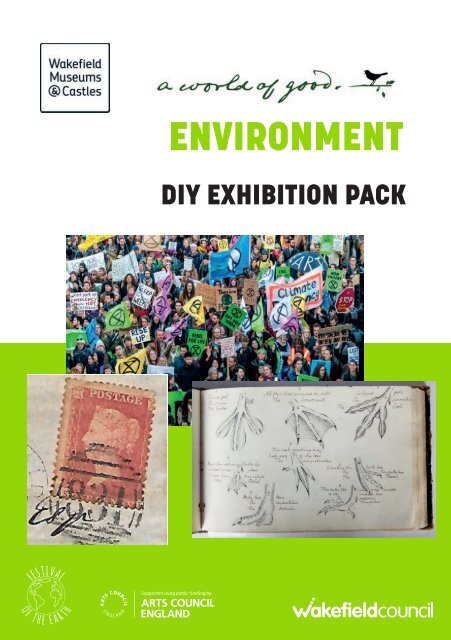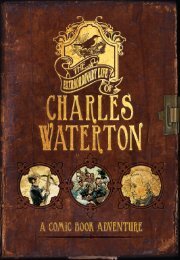A World of Good - DIY Exhibition Resource
Ever wondered what you could include to create an exhibition based upon the environment, nature & sustainability? We may have just the thing for you. Inspired by the A World of Good exhibition at Wakefield Museum download your DIY Exhibition Pack at https://bit.ly/AWoG_DIY-Exhibition
Ever wondered what you could include to create an exhibition based upon the environment, nature & sustainability? We may have just the thing for you.
Inspired by the A World of Good exhibition at Wakefield Museum download your DIY Exhibition Pack at https://bit.ly/AWoG_DIY-Exhibition
- No tags were found...
You also want an ePaper? Increase the reach of your titles
YUMPU automatically turns print PDFs into web optimized ePapers that Google loves.
ENVIRONMENT<br />
<strong>DIY</strong> EXHIBITION PACK
Before the industrial revolution, people generally lived in<br />
harmony with the land, seas and sky. We didn’t take<br />
more from the planet than it could afford and we didn’t<br />
produce more rubbish than the environment could<br />
absorb.<br />
Then the population grew. We figured out new ways to<br />
get more resources out <strong>of</strong> the land and invented<br />
machines to produce things on a much bigger scale. The<br />
world was busy and exciting, but the factories and<br />
industry spewed out more and more rubbish and<br />
pollution. The air became dirty, rivers and seas became<br />
polluted and plants and animals began to suffer.
THIS LAND<br />
IS OUR LAND<br />
Back in the 1800s, Charles Waterton<br />
was one <strong>of</strong> the first people to really<br />
worry about the side effects <strong>of</strong><br />
industrialisation. Charles loved<br />
nature. He climbed trees<br />
barefoot to get close to birds<br />
in his own garden in Wakefield.<br />
When he noticed species<br />
disappearing, he built a wall<br />
five miles long around his land,<br />
creating the world’s first nature<br />
reserve.<br />
When a factory started polluting<br />
the habitat, he fought them in<br />
court and had the factory<br />
relocated.<br />
This booklet is full <strong>of</strong> ideas for things you can do right<br />
now to keep our green places happy and protect the<br />
whole planet. We also hope you will make an<br />
exhibition to share your ideas and creations.
LOVE WHERE WE LIVE<br />
The large, grn, red headed wd pecker, this<br />
beautiful bird has returned d goes to bed<br />
every night (I mysлf tch him) wh thr<br />
f∈e shr nes. C.W.<br />
Charles<br />
Waterton was<br />
amazed by the plants and<br />
creatures he saw on his world<br />
travels, but he was equally excited<br />
by the woodpecker in his garden and the<br />
badgers in his woods. Any small green space<br />
can be an expedition into the unknown, full<br />
<strong>of</strong> wild species doing incredible things to<br />
survive.<br />
In the 19th century, naturalism was a very<br />
popular hobby. People studied the natural<br />
world, learning the names and behavoiur <strong>of</strong><br />
the different plants and animals. hey didn’t<br />
need a lot <strong>of</strong> equipment, just curiosity and<br />
the patience to watch and learn from the<br />
world around us.<br />
You don’t have to climb trees barefoot like<br />
Waterton. Why not tune in to a webcam with<br />
a nice cup <strong>of</strong> hot chocolate, or scatter some<br />
seed outside your window and see who turns<br />
For Your <strong>Exhibition</strong> : What plants, birds or animals<br />
would you like to see living in your neighbourhood? Create<br />
animal free taxidermy by sculpting a creature out <strong>of</strong> fabric,<br />
decoupage, clay or scrap materials.
Be a Researcher<br />
How has the<br />
environment<br />
changed over<br />
the years? Maybe<br />
you know someone<br />
who has been around<br />
a long time who you can<br />
ask. They might remember<br />
whether there was more<br />
wildlife around or whether there used to be less<br />
concrete. Maybe the air is cleaner now. They might<br />
even have photographs or objects you could borrow.<br />
Be a Victorian Naturalist<br />
Pack a bag with kit and provisions and go somewhere<br />
green. Think about how you can record what you<br />
discover. Could you take some photographs? Maybe<br />
you could write a poem that describes the<br />
smells, sights and sounds <strong>of</strong> this place, or<br />
I had the tufted duck d the<br />
pochard here, much earlier th<br />
i have ever sn them. The hers<br />
have bred plнtifully.<br />
C.W,<br />
how it makes you feel. Victorian<br />
naturalists would <strong>of</strong>ten use a<br />
sketchbook to paint or take<br />
notes in the field. They might<br />
also take bark rubbings<br />
or keep a diary.<br />
Remember :<br />
Do not move anything that’s alive<br />
and take your rubbish home with you.<br />
For Your<br />
<strong>Exhibition</strong>
THINK GLOBALLY,<br />
ACT LOCALLY<br />
Take a moment to imagine the world you’d like to live in. What<br />
problems would you solve? What new things or species would you<br />
introduce in your neighbourhood?<br />
Every one <strong>of</strong> us has the power to make a difference, to things like<br />
global warming, loss <strong>of</strong> species and plastic pollution. Write a<br />
pledge, what action will you take to spread positive change into<br />
the world? Could you drive less and walk more? What plastics are<br />
essential and which ones could you do without?<br />
If we keep up the work Waterton started, we can help the planet to<br />
recover and create beautiful neighourhoods full <strong>of</strong> colour and life<br />
at the same time.<br />
When you think about your local environment, what three<br />
changes would you like to see and what three things do you want<br />
to protect and make sure they stay the same?<br />
3 changes 3 protects<br />
My Pledge:
T A<br />
K<br />
E<br />
A C T I ON<br />
Charles Waterton was not afraid to ruffle a few feathers. His<br />
nature reserve was very close to a soap factory. Charles<br />
was worried that the chemicals produced would poison the<br />
water around the reserve. The factory owner promised not<br />
to let any chemicals escape into the rivers, but when they<br />
broke that promise, Charles was ready to take action.<br />
He took the soap factory to court for polluting the nature<br />
reserve and eventually, the whole factory moved to a<br />
different location. He also campaigned for the protection <strong>of</strong><br />
Heath Common using posters and letters to the press.<br />
Heath Common remains a conservation area to this day.<br />
Ruffle Some Feathers. We are<br />
stronger together. Can you<br />
organise a campaign, a celebration<br />
or a task force? Perhaps you could<br />
arrange a litter pick or a community picnic. You<br />
could create a poster or petition to raise awareness.<br />
Don’t forget to save images, souvenirs, press cuttings<br />
and banners for your exhibition.<br />
For Your<br />
<strong>Exhibition</strong>
PEOPLE POWER<br />
There are loads <strong>of</strong> things you can do to have a<br />
positive impact on your neighbourhood and your<br />
planet. Here are some ideas!<br />
Recycle<br />
Use less plastic<br />
Craftivism<br />
Listen for birds<br />
Rewild your garden<br />
Swap seeds<br />
Love insects<br />
Get an allotment<br />
Feed birds<br />
Walk more<br />
Eat less meat<br />
Buy fewer clothes<br />
Composting<br />
Cycle more<br />
Grow vegetables<br />
Make a bug hotel<br />
Avoid harmful chemicals<br />
Build a hedgehog home<br />
How many can you tick <strong>of</strong>f already?
WAKEFIELD<br />
NATIONAL PARK<br />
Search an online map for a satellite view <strong>of</strong> Wakefield. The<br />
town looks pretty grey, but zoom in on your neighbourhood<br />
and you will see lots <strong>of</strong> little pieces <strong>of</strong> green; verges,<br />
gardens, school fields and more.<br />
Even the tiniest patch <strong>of</strong> green is habitat for plants and<br />
creatures. If we added all these green fragments together,<br />
we might have enough for a Wakefield National Park!<br />
Complete the grid<br />
Allotments<br />
School Field<br />
Cemetery<br />
Anglers Park<br />
Bird Feeder<br />
Your Garden<br />
Verge<br />
The Nearest Tree<br />
To Your House<br />
Window Box
What places would<br />
you include in<br />
Wakefield National<br />
Park?<br />
Why not plant<br />
something and<br />
help make<br />
Wakefield<br />
greener<br />
For Your<br />
<strong>Exhibition</strong><br />
#DoA<strong>World</strong>Of<strong>Good</strong><br />
Make a map showing all the green<br />
places that are special to you. It could<br />
be digital, 2D or 3D sculpture. You could find an<br />
old map and embellish that. You could use paint,<br />
crayons, embroidery, minecraft, papier mache, collage<br />
or construction toys. You could use things from the<br />
garden or forest floor. It could be perfectly to scale or<br />
more impressionistic.
BUILDING YOUR<br />
<strong>DIY</strong> EXHIBITION<br />
Now you have lots <strong>of</strong> things to go in your exhibition,<br />
you need to decide how to display them.<br />
Should it be a physical exhibition or an online one?<br />
(You can use social media to curate your exhibition.<br />
Don’t forget to use the hashtag #DoA<strong>World</strong>Of<strong>Good</strong>)<br />
For inspiration visit Wakefield Museums A <strong>World</strong> <strong>of</strong><br />
<strong>Good</strong> exhibition to supercharge ideas for your<br />
exhibition<br />
Will your exhibition be ordered or freestyle?<br />
Will you choose a colour scheme?<br />
Do any <strong>of</strong> your exhibits need a label<br />
to explain what they are?
How much room do you have? You could use a<br />
piece <strong>of</strong> wall, upcycle a bookcase, create a<br />
window display or make a very tiny display<br />
inside a box. Look online or visit Wakefield<br />
museum for more ideas.<br />
Launch Your <strong>Exhibition</strong> : Throw a<br />
Party. A launch party is fun and also gives you<br />
the chance to invite people to see your hard<br />
work. You can send out invites, get snacks and<br />
drinks and give a tour <strong>of</strong> your exhibition on the<br />
day. If a few people have created a window<br />
display in your neighbourhood, you could arrange<br />
a walking trail to go and see them all. You could<br />
even have a street party to celebrate them all.








